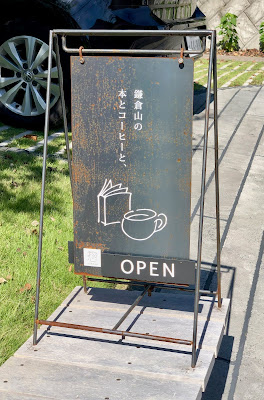目次 / Contents
1) 屋外 / Outside
2) 屋内 / Inside
3) 今日の本 / Today's Book
A. 『ことまもり いろまもり 』/ "Kotomamori Iromamori"
B. 赤い糸 / Red Thread
1) 屋外 / Outside
 'ブックカフェ・"惣common" |
私と夫Rは、鎌倉山の 'YAMA, Gallery 招山' で、 しゅんしゅん個展 "平素" を見た後に 'ブックカフェ・"惣common" へ行きました。 個展については下記。 Book Cafe ・"So common" After seeing Shun Shun Exhibition : 'Heiso' in 'YAMA, Gallery Shouzan' in Kamakurayama, I and my husband R went to Book Cafe ・"So common". About the Exhibition is below. 本のページの暖簾 (ノレン) が入り口です。 The entrance has a Noren of an open book image. |
According to Wiki about Noren,
"Noren (暖簾) are traditional Japanese fabric dividers hung between rooms, on walls, in doorways, or in windows. They usually have one or more vertical slits cut from the bottom to nearly the top of the fabric, allowing for easier passage or viewing.
~~
2) 屋内 / Inside
今日は、気持ちの良い気候でした。
なので、カフェでは屋外席に座ろうと考えていましたが、先客がいました。
カフェの方(スタッフ)は私達を見るなり、
「今日は外の席が気持ち良いですよ」
と勧めてくださりました。
「はい、私もそう思って来たのですがもう先客がいらして...」
屋内も、今まで一番混んでいました。
お気に入りの席もすでにどなたかいました。
初めて書棚と書棚の間の席に座りました。
その席からは、大きな窓から、外が眺められます。
日の光が柔らかくデッキ席や竹藪に指していました。
しゅんしゅんさんの絵のような穏やかさがここにもありました。
景色を眺めつつ、個展の様子を反芻しつつ、お気に入りの抹茶ラテを飲みました。
 |
| 赤とグレイ 赤いカップはカフェラテ、 グレイのカップは抹茶ラテです。 前回も同じものを注文しましたがカップの色は前回とは 逆で、新鮮な驚きを感じました。 '思い込み' をしていた自分に反省が入りました。 Red and Grey The red cup is a latte and the gray cup is a Matcha latte. We ordered the same drinks last time, but the colours of the cups were the opposite of the last time, and I felt a fresh surprise. I reflected on my having "preconceptions". |
Inside
It was a pleasant climate today.
So I was thinking of sitting outside at the cafe, but other customers were there already.
As soon as a staff looked at us, he recommended that
The outside seats are comfortable today."
"Yes, I thought so too, but there are already people ..."
The inside was also the busiest so far.
Someone already had our favourite table.
For the first time, we sat on the seats between the bookshelves.
From these seats, we can see the outside through a large window.
The sunlight was soft and pointed to the deck seats and bamboo woods.
Here was also calmness, like Shun Shun's pictures.
I drank my favourite matcha latte while looking at the scenery and reflecting on his exhibition.
3) 今日の本 / Today's Book
A.『ことまもり いろまもり』
"Kotomamori Iromamori"
 |
| 『ことまもり いろまもり』 : ★ 作 : 西芳 友里 (サイホウ ユリ/ ?~ ) (13篇の詩と挿絵) この本は手作りの装丁のようでした。 綺麗な本で心に残りました。 非売品でちょっと残念。 "Kotomamori Iromamori" : ★ By Yuri Saihou (?~) (13 poems and illustrations) This book seemed to be a handmade binding. It was a beautiful book that left a lasting impression on me. Not for sale and a little disappointing. |
B. 赤い糸 / Red Thread
現在、鎌倉には、フルーツ大福のお店が2つあります。
2つの店とも、食べる人が大福を糸で切ることを特徴としています。
華菱では、大福を糸で切るのではなく、
「赤い糸で、ご縁を結ぶ糸結び」
と設定されています。
「赤い糸で、ご縁を結ぶ糸結び」
と設定されています。
ここでこの話を出したのは、『ことまもり いろまもり』が、赤い糸で製本されているからです。
赤い糸を用いている何かはたくさんありますが、最近、私の環境下でリンクしたのです。
『ことまもり いろまもり』で赤い糸が使用されたのは、赤い糸で、言葉と絵を結ぶという発想ではないかと思いました。
日本では赤い糸の伝説が行き渡っていて、日本人には、'赤い糸'への特別なイメージがあり、それを踏まえたアイディアがさまざまな日本文化に生かされているように思います。
Red Thread
Currently, there are two fruit Daifuku shops in Kamakura.
According to Wiki about Daifuku,
"Daifukumochi (大福餅), or daifuku (大福) (literally "great luck"), is a wagashi (Japanese confection) consisting of a small round mochi (glutinous rice cake) stuffed with sweet filling, most commonly anko, sweetened red bean paste made from azuki beans.
Daifuku is a popular wagashi in Japan and is often served with green tea."
One is "Benzaiten", which is popular all over the country, and the other is "Hanabishi", which has its main shop in Kita-Kamakura and recently opened the Wakamiya Ōji street shop.
Both shops are characterized by the eater cutting Daifuku with thread.
"Benzaiten" uses white thread, and "Hanabishi" uses red thread.
At Hanabishi, instead of cutting Daifuku with a thread, it is described as "a thread knot that ties the edges with a red thread."
I told this story here because "Kotomamori Iromamori" is bound with red thread.
In Japan, there are a lot of things that use red thread ideas, but recently I linked these things in my environment.
I thought that the red thread used in "Kotomamori Iromamori" has the idea of a thread knot that ties words and illustrations.
The idea is based on Red Thread of Fate, widespread in Japan, so Japanese people have a special image of 'Red Thread', and I think that ideas based on that are applied in various Japanese cultures.



0 件のコメント:
コメントを投稿